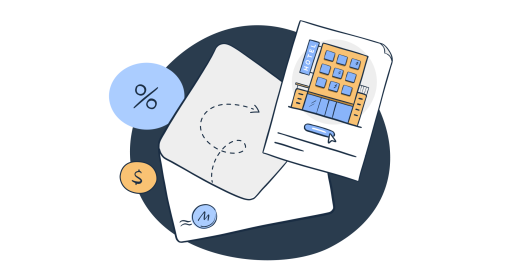Email marketing is an essential tool for businesses of all sizes, and hotels are no exception. A well-crafted strategy can help hoteliers acquire new customers, drive more bookings, build a lasting relationship with their guests, and essentially increase their revenue.
This article will provide a definition of email marketing for hotels, along with examples, useful tips, and software recommendations to help you build a successful strategy.
What is email marketing for hotels?
Email marketing for hotels is a type of email marketing that is built around the peculiarities of the hospitality industry. It involves all sorts of campaigns, such as hotel newsletters, confirmation emails, special offers, welcome emails, etc. The focus of these campaigns is to highlight the destination, emphasize reviews and social proof, and use personalization to provide customized recommendations.
Customer journey stages in hotel email marketing
Just like any other type of email marketing, email marketing for hotels is aligned with customer journey stages to move leads through the marketing funnel. However, they look different from the classic stages (awareness, consideration, purchase, retention, advocacy). We can identify five main stages: research or pre-booking stage, booking stage, pre-arrival stage, stay stage, and post-stay stage.
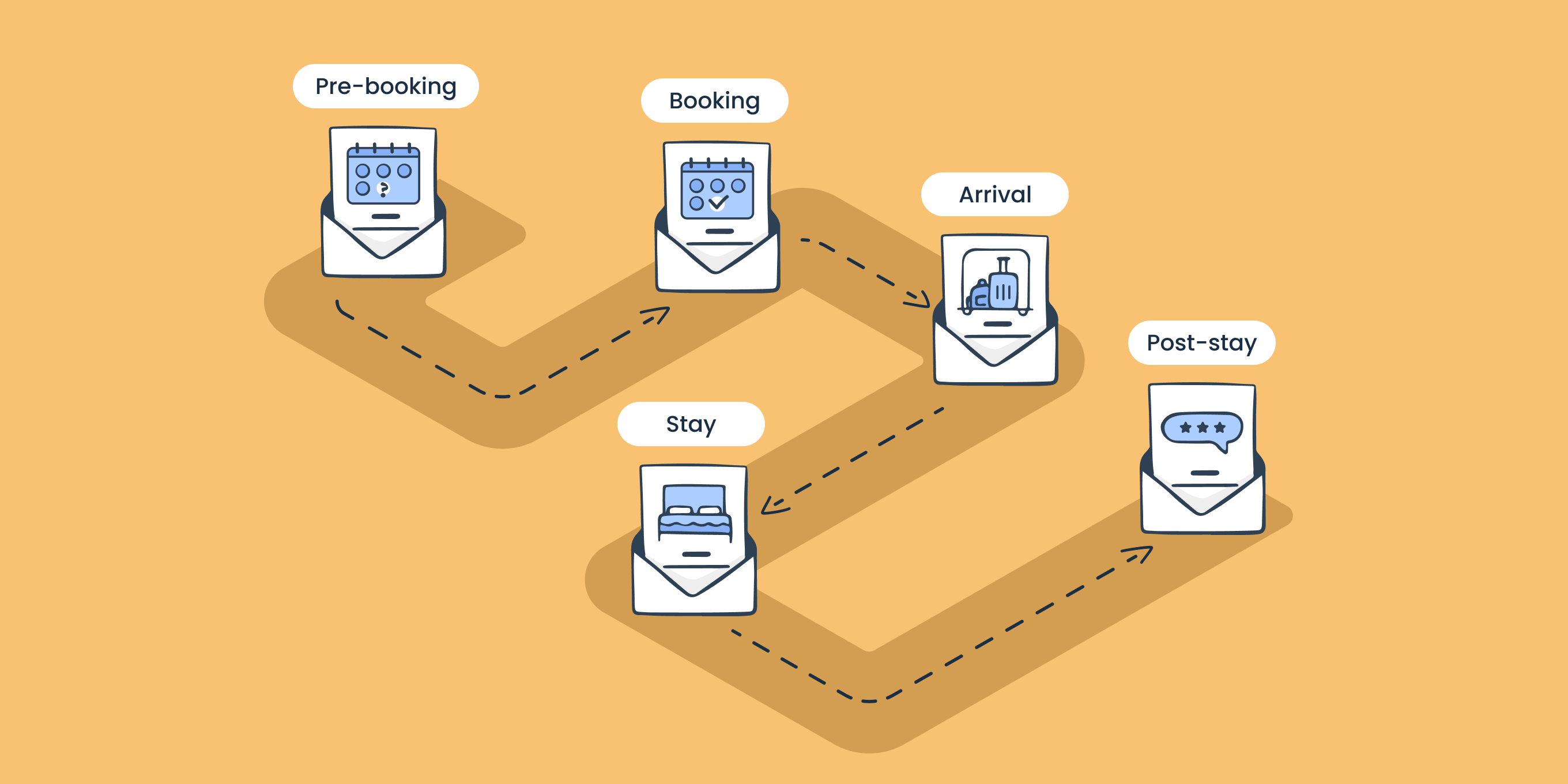
Research or pre-booking stage
The research or pre-booking stage is equivalent to the awareness stage. In this stage, a potential guest is researching hotels and comparing prices and reviews. Hotel owners/marketers can use this opportunity to run informational email marketing campaigns. These can include recommendations on activities or attractions in selected destinations.
Another option is to motivate potential hotel guests to book your accommodation. This can be done by influencing their choice with social proof, testimonials, or reviews.
It’s also a good idea to send special offers and promotional emails. Pricing is a major factor when choosing a hotel, and leveraging this opportunity can certainly help drive more traffic.
Booking stage
Next comes the booking stage i.e., the guest has chosen your hotel for their stay. After the reservation is received through the hotel inventory management platform, hotel marketers should send confirmation emails to verify the booking and include necessary details, such as date, room type, check-in and check-out times, etc. Don’t forget to include information about your policies (such as cancellation, pet, and number of guests, for example).
To make this process easier, you can create workflows and send automated emails for confirmation. They will be triggered after the booking, requiring minimal effort from you.
The booking stage is also perfect for upselling emails. With those, you can offer room upgrades and promote additional amenities.
Pre-arrival/arrival stage
Pre-arrival/arrival stage begins before the guest’s planned stay. And since this stage can be stressful for the guest, you should try to ease it as much as possible with your hotel email marketing campaigns.
One way to do this is to implement an online check-in. You could craft a simple email and direct guests to the hotel website, specifically to the landing page where they can complete the check-in. This step will be a bit tricky if you don’t have a website, though. In that case, it’s better to skip online check-in altogether. Asking for sensitive information over emails is a bad practice, and could significantly damage your hotel’s brand.
In the pre-arrival/arrival stage, you can once again promote additional amenities through emails, such as airport transportation, restaurant reservations, all-inclusive deals, spa treatments – basically anything that could improve the quality of the guests’ stays.
Stay stage
The stay stage begins as soon as your guests arrive at your hotel and lasts until they leave. In this stage, you should focus on making their stay comfortable and enjoyable. Emails with personalized recommendations about local attractions and experiences should do the trick.
Post-stay stage
The post-stay stage is all about nurturing your relationship and turning your guests into loyal customers. At this point, the guest has checked out from your hotel, so the goal should be to keep them coming back. You can ask them for a review, offer a discount on their next stay, or ask them to join your loyalty programs, if any.
Hospitality email marketing examples
Now that you understand what hotel email marketing is, let’s dive into some of the samples of email marketing letters.
The Hoxton – Special Offer
Special offer emails are a great way to attract new customers and motivate existing ones to book your stay. These can be couples or children discounts, voucher codes, discounts on a specific location, or free accommodation upgrades. Such offers can increase your traffic on slow weekends and seasons. You could make them targeted to specific audience segments, such as bachelorettes, couples, business travelers, or school children.
Special offer email marketing campaigns help you stay on top of the competition and linger in potential guests’ minds the next time they plan a vacation or a weekend getaway.
Below you can see a great example of the special offer email from The Hoxton.
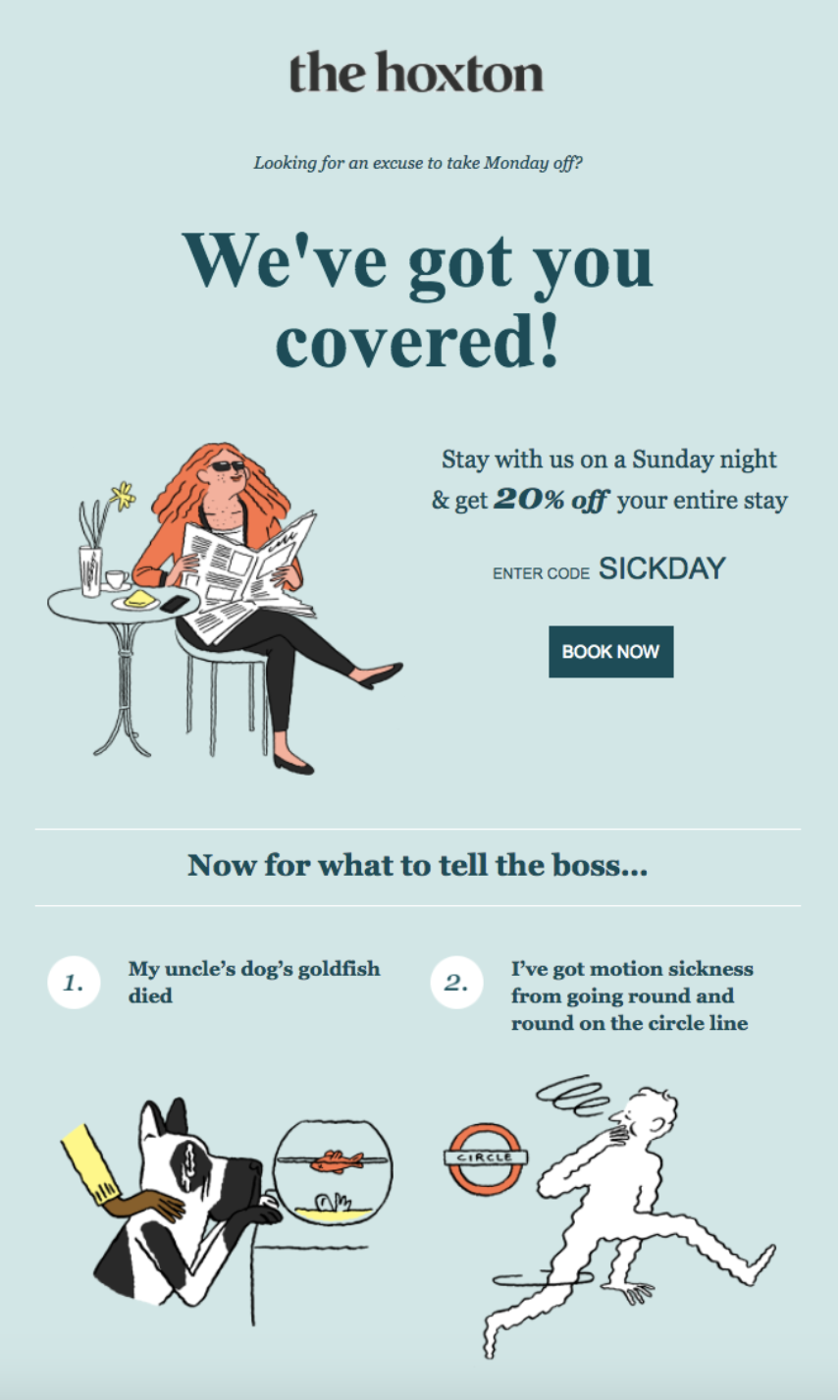
What we like:
- The copy is well-crafted and has a humorous tone, matching the industry and the vibe of the email.
- The illustrations are smart and eye-catching.
- The discount is generous.
- The email includes clear instructions on what the user should do to get a discount.
What could be improved:
- On the technical side of things, the language attribute isn’t clearly defined, which may hinder the transcription of the message if English isn’t the default language for the users’ screen reader.
- Table roles aren’t clearly defined.
137 Pillars Hotels & Resort – Cross-selling email
Cross-selling emails can help hotels promote different services at the same time. Typically, such emails promote amenities, restaurants, or events along with the rooms. However, this technique is also suitable for hotels that have several locations.
That’s exactly how 137 Pillars Hotels & Resorts uses cross-selling in the email below.
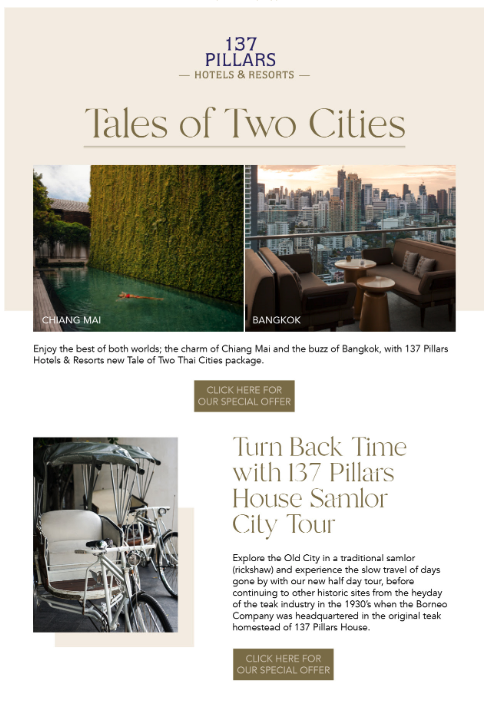
What we like:
- Effectively employs cross-selling technique by combining two locations in one package
- The design is simple and shows the pictures of the destinations included in the package
- Includes useful tips from the staff
- Takes a location-driven approach instead of focusing on prices and deals
What could be improved:
- CTA (call to action) buttons could have been more concise and clear
- More information about the package would help set the right expectations for potential guests
Ace Hotel Pittsburgh – Seasonal Events and Happenings
Seasonal events and happenings can be part of your email newsletter campaigns or be launched separately depending on the upcoming holidays. Hotel marketers can use these emails to promote their events and provide a sneak peek into the activities that will be happening during the season.
Event calendars can be made into targeted emails with personalized recommendations for audience segments that are planning their stay in a specific timeslot. Alternatively, they can be general and list different types of activities to captivate the attention of a wider audience.
Ace Hotel Pittsburgh takes a general approach and offers various events that accommodate people with different interests.
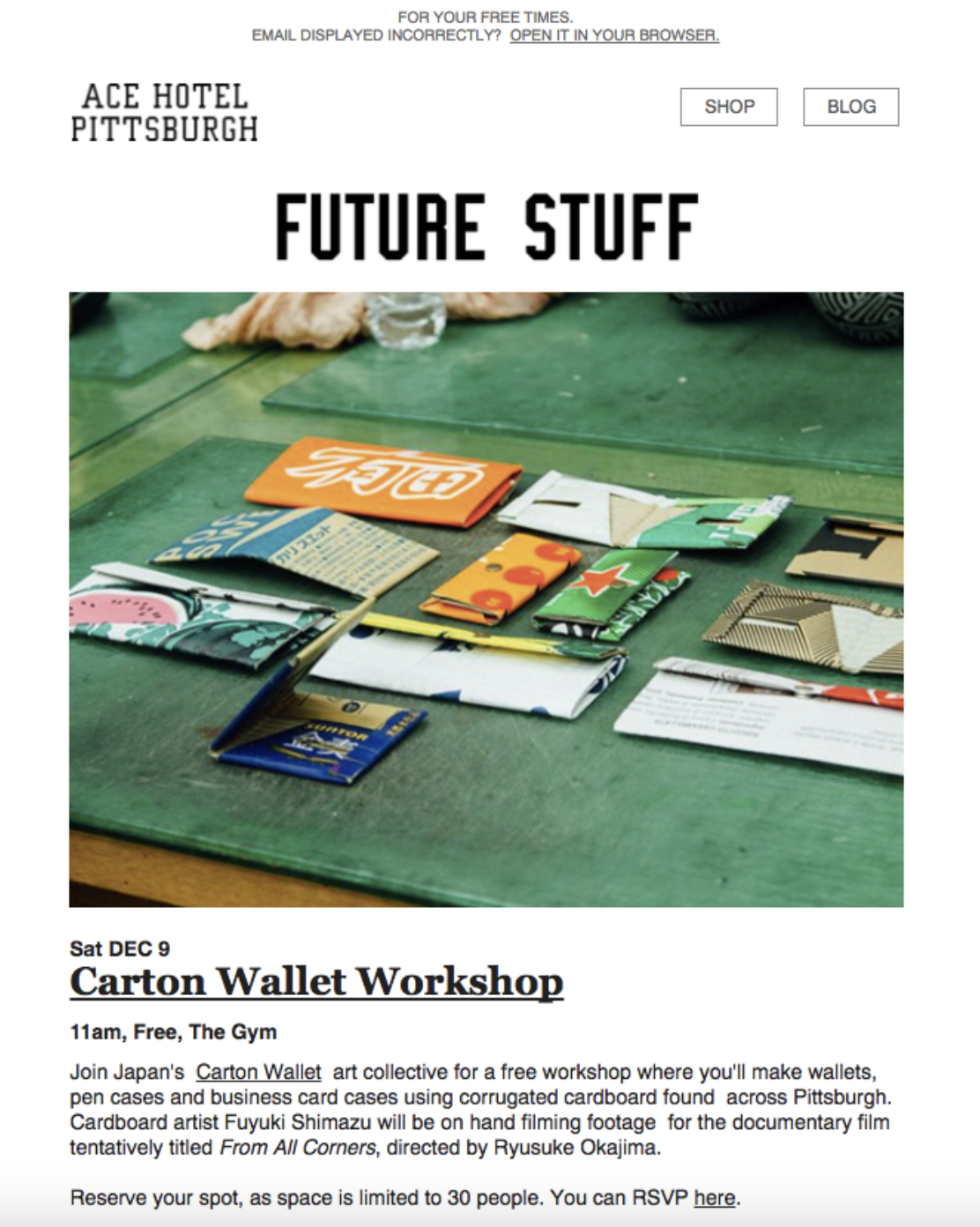
What we like:
- The email is informational and includes small descriptions and useful links for each event
- The design is simple and includes one banner and one image
- The structure and headings are clearly defined
What could be improved:
- The CTAs aren’t clear and concise
- The email contains around 20 links (maybe more). The rule of thumb is to keep the number of links under 5 to avoid damaging sender reputation and email deliverability
Pros and cons of email marketing for hotels
To help you decide if email marketing is a good fit for your hotel business, we decided to compile a quick list of pros and cons.
| Advantages of email marketing for hotels | Disadvantages of email marketing for hotels |
| Drives revenue: the average conversion rate across EMEA, LATAM, APAC, and NAM regions amounts to around 0.3%. This means that if you send 1 email to 1,000 potential guests, you could achieve 300 reservations. Increases guest engagement and loyalty: personalized and segmented campaigns allow hoteliers to nourish customer relationships, provide essential information, and employ upsell and cross-sell techniques. Best ROI compared to other digital marketing channels: on average, email marketing generates $36 for every $1 spent, compared to digital search advertising ROI of $11. | Privacy concerns: hotels have access to their guests’ private and sensitive information. While such data can help with personalization, using it could raise significant privacy concerns among customers. Requires expert resources: just like any other type of email marketing, email marketing for hotels requires a team of marketers, researchers, copywriters, and sometimes developers for the campaigns to be successful. This may be too big of a financial burden for small hotels with limited resources. |
Hotel email marketing best practices
For your email marketing efforts to be successful in the hotel industry, it’s essential to know what you’re doing and how to execute result-driven campaigns. The following best practices will help you in that process.
1. Define strategy
When we talk about email marketing, the first step should always be creating an email marketing strategy. It will be a complete guide that will include the following elements:
- Identification of the problem to clearly define what issues your product is facing currently;
- Comprehensive research to figure out what your target audience lacks in your competitors’ products;
- All possible solutions that will help you solve the problems you defined;
- A detailed roadmap with an email content plan and a schedule for your campaigns.
You should take the same approach while building your hotel email marketing strategy. The final product should include information about your goals, ways to achieve them, and a precise timeframe.
Let’s assume you have a hotel in a great location, but you’re not receiving as many reservations as you’d like. In that case, your goal would be to improve overall brand awareness and maybe boost hotel revenue by 5%. How are you going to accomplish that goal with email marketing?
The answer could be running campaigns that provide information about your amenities, user reviews, and your values. Then you could follow them with promotional emails with referral discounts to reach a wider audience.
When you have all of that sorted, you should segment your target audience based on demographics, traveler types, interests in events, interests in active or passive leisure, etc. You can potentially pull that data from your Property Management System (PMS). It’s recommended to target each segment with personalized campaigns.
Try to keep your segments under 5,000 contacts. According to Revinate’s 2023 benchmark report, such segments have the highest open and click-through rates (49% and 8%, respectively). The rates decrease slowly as the size of the segment grows.
2. Choose software
You’ll need to find reliable software to send all those campaigns. The market is saturated with email marketing tools with shiny features. In the following sections, we’ll list some of the options. But before we get to that, you should know how to pick a robust solution. Here are the criteria you could use:
- High email deliverability rates to ensure your emails land in inboxes;
- Great uptime to ensure the system is up and running all the time;
- Marketing automation features to automate workflows and easily send different types of emails;
- Scalable infrastructure to meet the needs of a growing hotel business;
- Suppression management to control and track unsubscribes;
- Email design tools to send put-together emails;
- Integrations with various platforms and services;
- Clear API documentation and integration support;
- Responsive customer support to assist with any issues;
- Value for money and pricing structure.
3. Collect contacts and validate them
You won’t be able to reach potential guests unless you have an email list. Building it isn’t an easy task, and you won’t complete it overnight.
You could run various activities to collect contacts. For example, ‘give away’ a free stay and promote it through multiple social media channels you manage. To enter, ask people to sign-up for your marketing emails and send them detailed instructions. Alternatively, write a useful guide for the travelers in your location and make it accessible through an email signup.
The key is to ask users for consent before you target them with marketing materials. You can add a consent checkbox in your sign-up form. Getting permission to send marketing emails is crucial in order to comply with GDPR, CAN-SPAM, and other privacy laws and regulations. Using a double opt-in (sending a confirmation email after the user marks the consent checkbox) is also a good idea.
Remember to never buy email lists. Such email lists are filled with all sorts of contacts, most of which probably won’t care about your hotel. In other words, you’ll receive a lot of unsubscribes and spam complaints. Bought email lists usually contain spam traps i.e., first-class tickets to IP blocklist.
When you’re done collecting contacts, validate them to make sure all the email addresses still exist and avoid high bounce rates. Some email service providers come with a validator tool by default. If not, you could use separate software to scan and clean your list.
4. Craft content and start sending
Drafting a good email that will catch the eye of the inbox owner starts with the email subject line. Try to find a balance between being catchy and sounding spammy. Depending on the audience, short and concise subject lines could work better compared to complex copies.
One way to verify that is to run A/B testing campaigns with different subject lines and identical body content. Stick to the approach that proves to work better for your hotel brand and audience.
There’s a lot you can do when it comes to email content. You could use a humorous tone or turn the peculiarities of the travel industry to your advantage. Several dos and don’ts to remember:
- Don’t make your emails too long;
- Do provide important information right in the email;
- Don’t overwhelm the content with links;
- Do use 1-2 clear CTA buttons;
- Don’t use spammy words;
- Do concentrate on providing value to your potential guests.
You’re also free to use interactive emails (or any other type, for that matter) to allow your guests to engage with the content.
Don’t forget to optimize your emails for mobile devices and mailbox providers, and check how they look with dedicated tools (more on that later).
5. Analyze results & test different things
Your job is far from done once the emails are sent on their merry way. You’ll need to collect the results of your campaign, specifically essential metrics such as email open rates, click-through rates, conversion rates, bounce rates, and unsubscribes. While looking at metrics, examine the hotel industry benchmarks to determine how well your campaigns have performed.
View each campaign as a testing playground. The metrics will show you which campaigns performed better, but they won’t contain information about the causes. Build hypotheses for possible causes and make adjustments in your next campaigns. Email marketing is all about experimentation, be it a hotel or any other industry.
Here’s a checklist you can use to ensure you don’t miss any important steps.
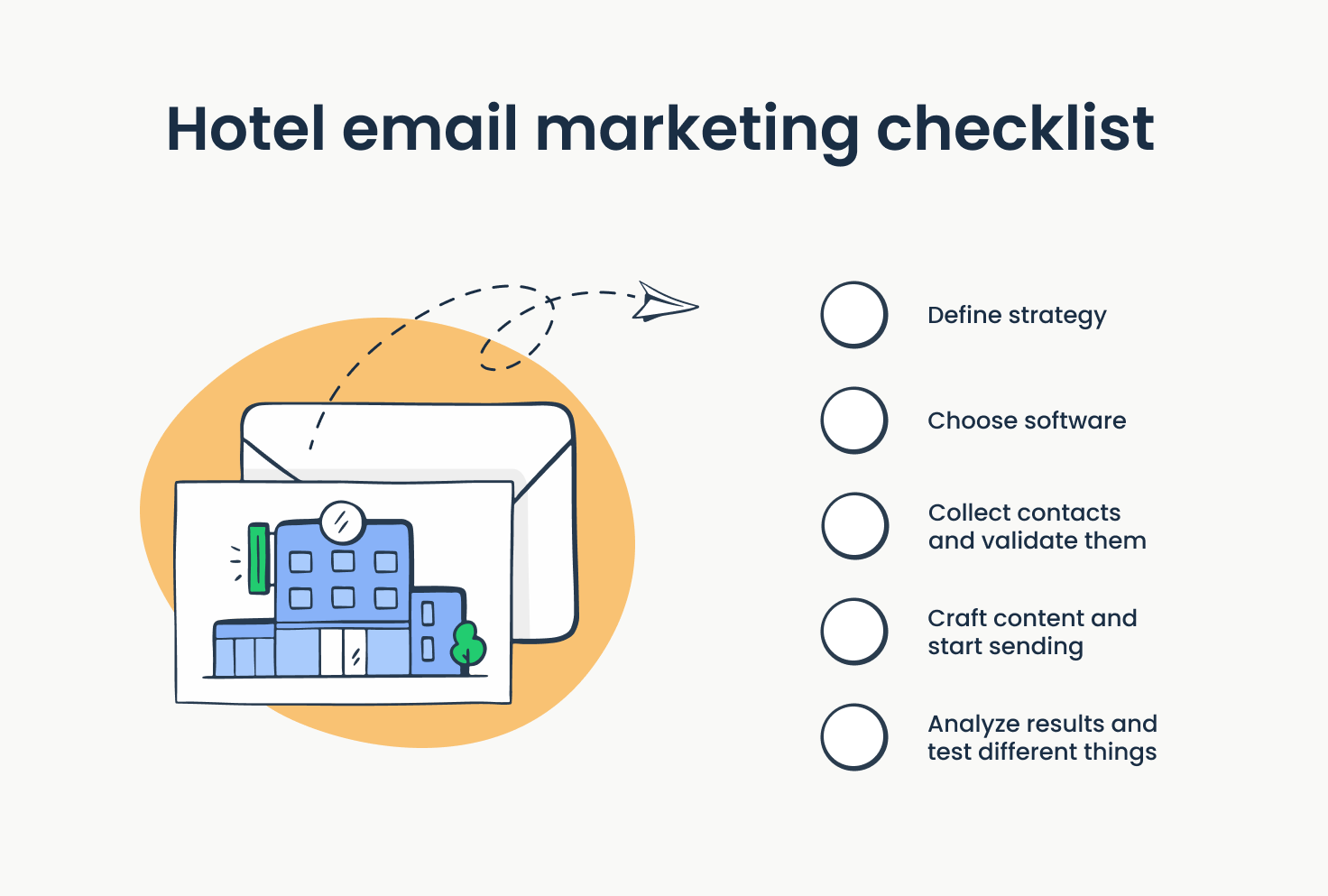
Email marketing templates for hotels
Above, we provided some hotel email marketing examples that you could use for inspiration. But we decided to take it a step further and provide templates for common email types.
Below you’ll see hotel email marketing templates for confirmation, cancellation, upsell, pre-arrival, and post-stay emails. You can customize these templates to match your audience and hotel brand.
Confirmation email
An email that confirms a hotel reservation should include:
- Guest’s name and reservation number
- A thank you message on behalf of the hotel
- Reservation dates
- Room details
- Payment information
- Amenities at the guest’s disposal
Subject: Reservation Confirmation at [Hotel Name] – [Reservation Number]
Dear [Guest Name],
Thank you for choosing [Hotel Name] for your upcoming stay. We are delighted to confirm your reservation with us.
Your Reservation Details:
Arrival Date: [Date]
Departure Date: [Date]
Room Type: [Room Type]
Number of Rooms: [Number of Rooms]
Number of Adults: [Number of Adults]
Number of Children: [Number of Children]
If any of the above information is incorrect, please let us know as soon as possible.
We look forward to welcoming you to our hotel on [Arrival Date]. Our friendly staff will be ready to assist you in any way possible to make your stay as comfortable and enjoyable as possible.
Should you have any further questions or requests, please do not hesitate to contact us at [Hotel Contact Information].
Thank you again for choosing [Hotel Name], and we look forward to serving you soon.
Best regards,
[Your Name]
[Hotel Name]
Upsell email
The components of the upsell email are the following:
- Offered additional amenities or services
- High-quality photos of the amenities or services
- Pricing information
- Discount details
- Link to a landing page containing a detailed list of offers
Just like the confirmation email, it should be personalized and contain a thank you note from the hotel.
Subject: Upgrade Your Experience at [Hotel Name]
Dear [Guest Name],
Thank you for choosing [Hotel Name]! We’d like to make your upcoming stay as enjoyable as possible, so here’s a short overview of additional services and amenities:
- SPA treatment
- Thermal mineral water swimming pool
- Gym
[CTA: Additional Services]
We have a special [Discount %] discount for our guests! Feel free to contact us for more information.
Best regards,
[Your Name]
[Hotel Name]
Pre-arrival email
Pre-arrival emails should be short and precise:
- Check-in and check-out times
- Hotel name and location
- Wi-Fi, food, and parking availability
- Local events and attractions (include images)
- Additional amenities/services that are available
- CTA to contact the hotel for additional information
Subject: Upcoming Stay at [Hotel Name] – [Reservation Number]
Dear [Guest Name],
We’re looking forward to your stay at [Hotel Name] on the [Check-in Date]! We’d like to remind you that the check-in time is at [Check-in Time] and check-out is at [Check-out Time].
We offer free Wi-Fi and parking on site, and local attractions include [List Local Businesses].
If you have any questions or have difficulties finding us, don’t hesitate to reach out!
[CTA: Contact us]
See you soon!
Best regards,
[Your Name]
[Hotel Name]
Cancellation email
When someone cancels their reservation, there’s not much to do. You can express how sorry the hotel is, remind them of the refund policy, and offer a discount for rescheduling their stay. You should also include their reservation details, such as confirmation numbers, dates, and names.
Subject: Cancellation Confirmation for [Reservation Number] at [Hotel Name]
Dear [Guest Name],
We’re very sorry you had to cancel your stay with us on [Arrival Date]! The [Hotel Name] cancellation policy states that [Cancellation Policy] and a fee of [Cancellation Fee] will be applied.
Your Reservation Details:
Arrival Date: [Date]
Departure Date: [Date]
Room Type: [Room Type]
Number of Rooms: [Number of Rooms]
Number of Adults: [Number of Adults]
Number of Children: [Number of Children]
If you’d like to reschedule your stay instead, we’d like to offer you a discount of [Discount %]!
[CTA: Contact us]
Best regards,
[Your Name]
[Hotel Name]
Post-stay email
Shortly after guests leave your hotel, it’s time to send them a thank you message that also includes:
- Surveys that assess their experience
- Links to your hotel’s social media profiles
- CTA to leave a positive review of their stay
- Special offers for their next visit
Subject: Rate Your Experience at [Hotel Name]!
Dear [Guest Name],
We’d like to thank you once again for choosing [Hotel Name] for your stay! We hope you’ve had a pleasant visit and that we’ll see you again. We’re always aiming to improve our services, and we need your help! If you can spare 3 minutes, please fill out our short survey.
[CTA: Start Survey]
And if you’d like to share your guest experience, please tag our profiles on social media!
[Hotel Brand’s Social Media Links]
As a thank you, we’d like to offer you a special discount of [Discount Amount] for your next stay!
Best regards,
[Your Name]
[Hotel Name]
3 best email marketing software for hotels
As we already mentioned, choosing the best email marketing tool is important for running successful campaigns. Here are three options you could use:
Mailchimp
Mailchimp is an all-in-one marketing platform that allows hotel marketers to create segmented lists, run A/B testing and automated campaigns, and use ready-made or custom templates. This tool also has integrations with popular PMSs to streamline the process of collecting guest data.
Mailchimp has a limited free trial and multiple contact-based pricing plans.
ActiveCampaign
ActiveCampaign is an automation platform that has advanced contact management, automation workflows, CRM integration, and analytical features. With the help of this tool, you can send trigger-based campaigns depending on your guest’s customer journey and behavior, and easily segment your audiences. ActiveCampaign also has a free trial and feature-based plans suitable for hotels of all sizes.
MailerLite
Similar to Mailchimp and ActiveCampaign, MailerLite also has all the essential marketing features that you’d need to run successful hotel email campaigns. Additionally, it allows you to ask for guests’ reviews through email-embedded surveys. MailerLite has a free trial and a free plan that is sufficient enough for small hotels. Paid plans are also available for when your hotel business grows, and your email marketing needs increase.
Keep in mind that with all three tools, you’ll need a separate plan to send transactional emails, such as password resets and payment invoices.
What about testing your hotel marketing emails?
As we mentioned above, it’s important to check how your emails will look on different devices and mailbox providers. But it’s even more essential to test the technical portion of your marketing emails to achieve high deliverability rates.
You can do that with dedicated tools, such as Mailtrap Email Testing, for example. It’s an Email Sandbox that provides a safe environment for testing by capturing all the SMTP traffic in a virtual inbox.
Start Testing Your Hotel Emails for Free
Email Testing will help you validate HTML/CSS for popular email clients. You’ll see problematic lines of code highlighted in red, as well as an overview of clients that won’t render your emails properly.
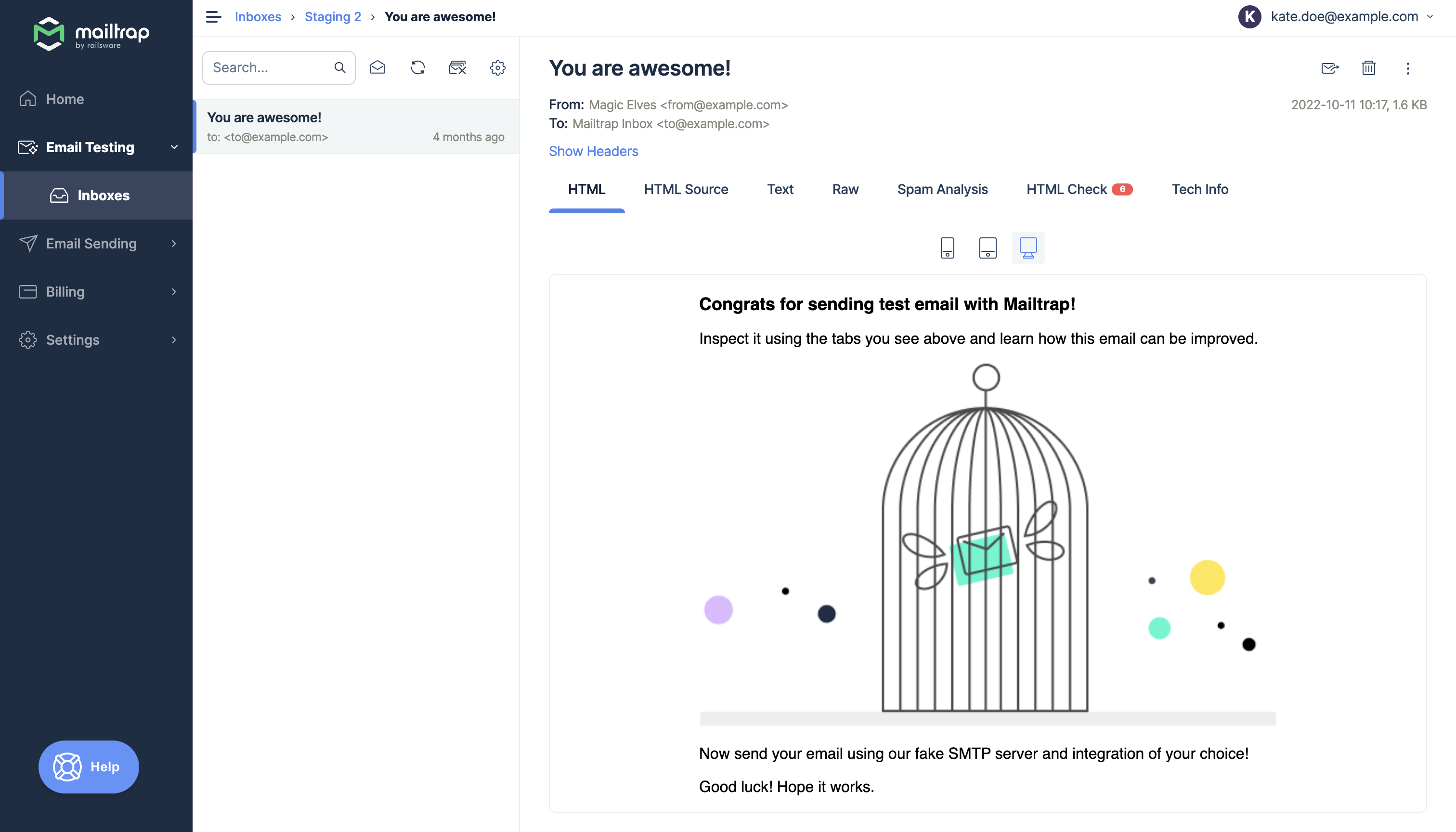
With this solution, you can also see what emails will look like on a desktop, mobile, or tablet and make adjustments accordingly. While you’re at it, you can check the spam score to avoid spam complaints when you start sending your emails.
Email Testing enables marketers and managers to easily collaborate with QA and dev teams and send polished emails to recipients.
Wrapping up
There’s no quick way to create the best email marketing for hotels. It requires a lot of research, expertise, and effort to do everything right. And while you won’t achieve success without investment, you’ll eventually get substantial returns.
Make sure you build an email marketing strategy based on customer journey stages. That way, you’ll send targeted emails that will connect you with current, future, or past guests. That’s all!
If you’re interested in email marketing in general, check out our blog posts about referral email marketing, email marketing funnel, email blast, or email marketing ideas.

